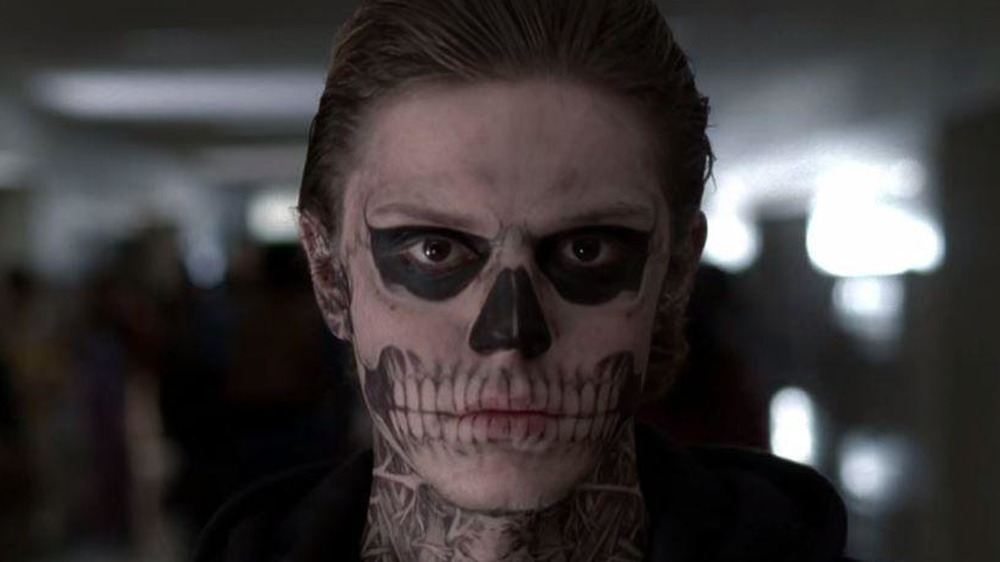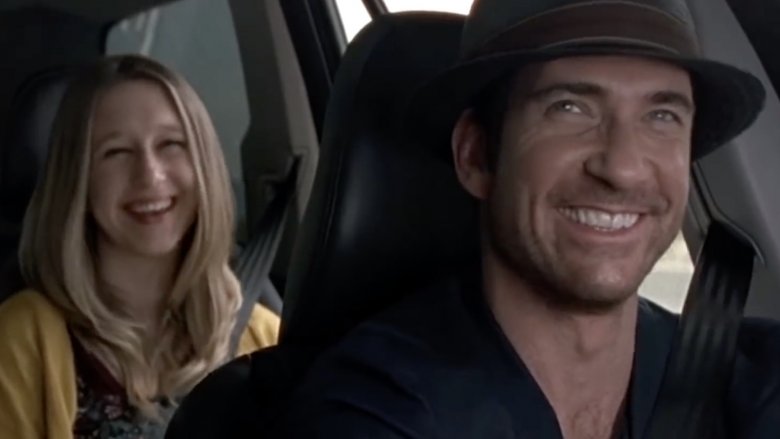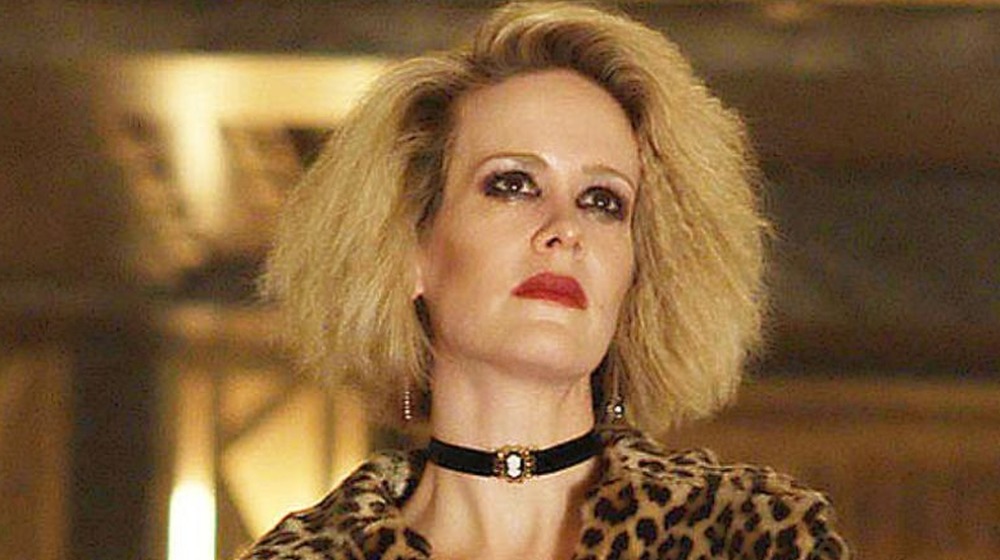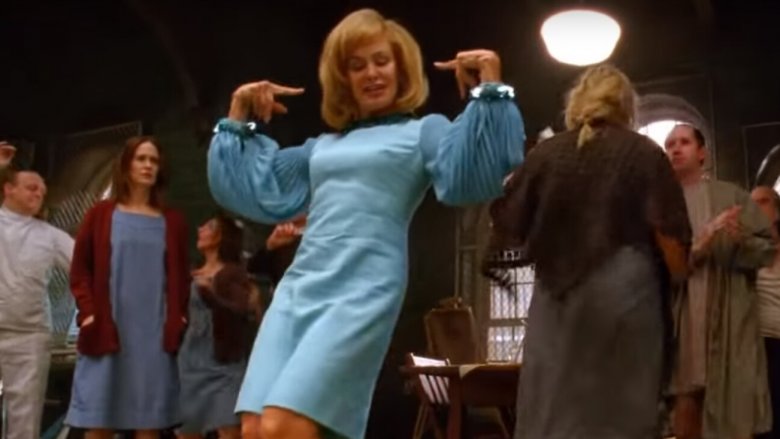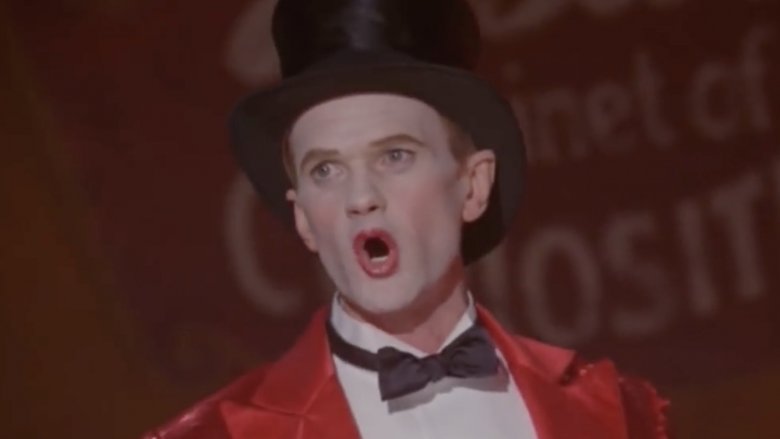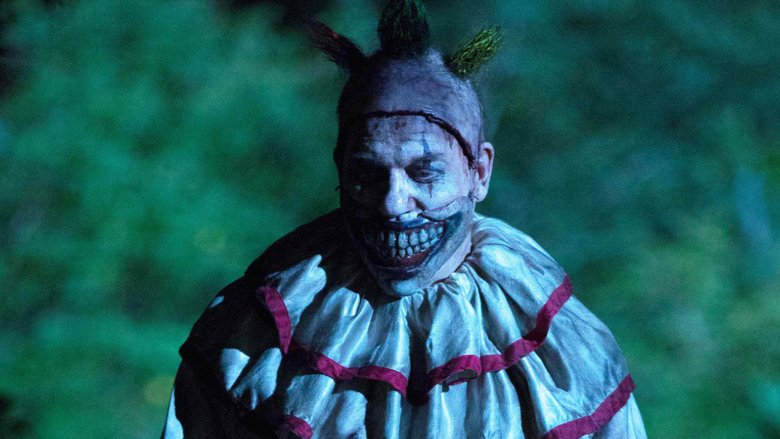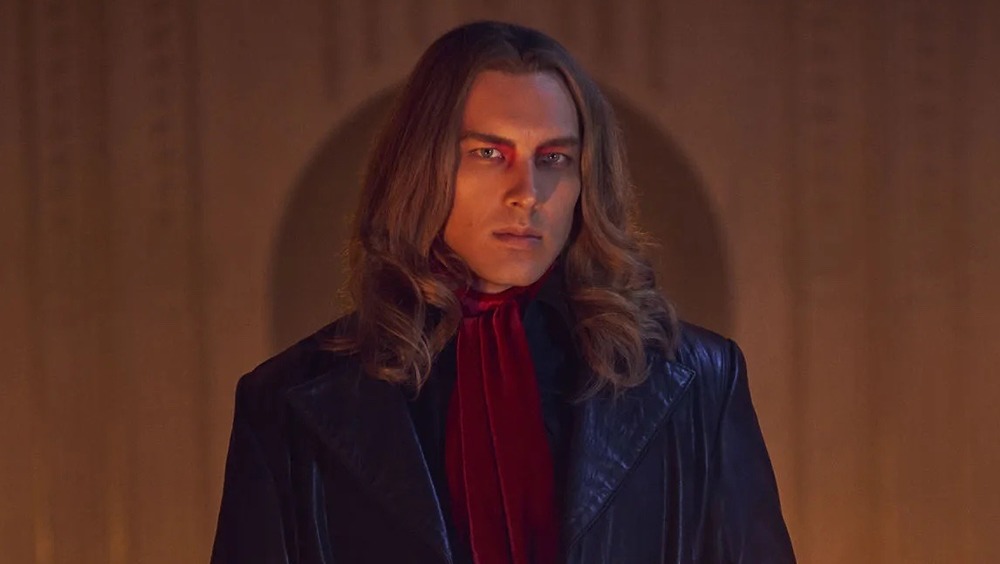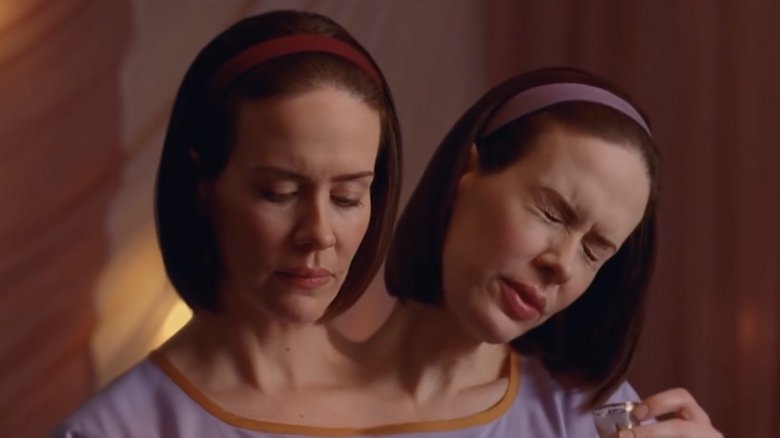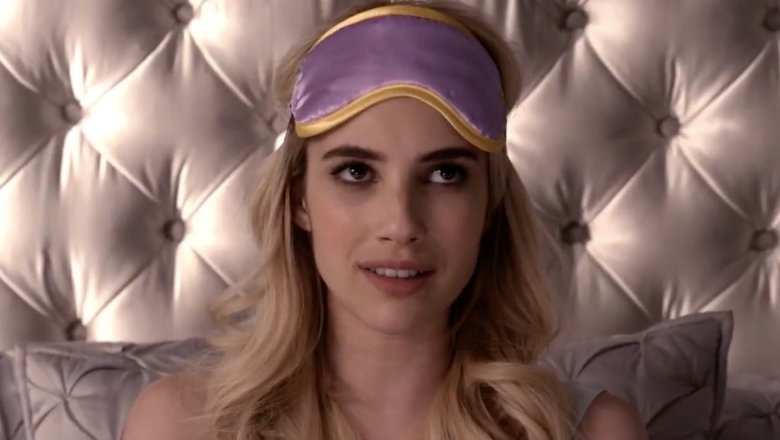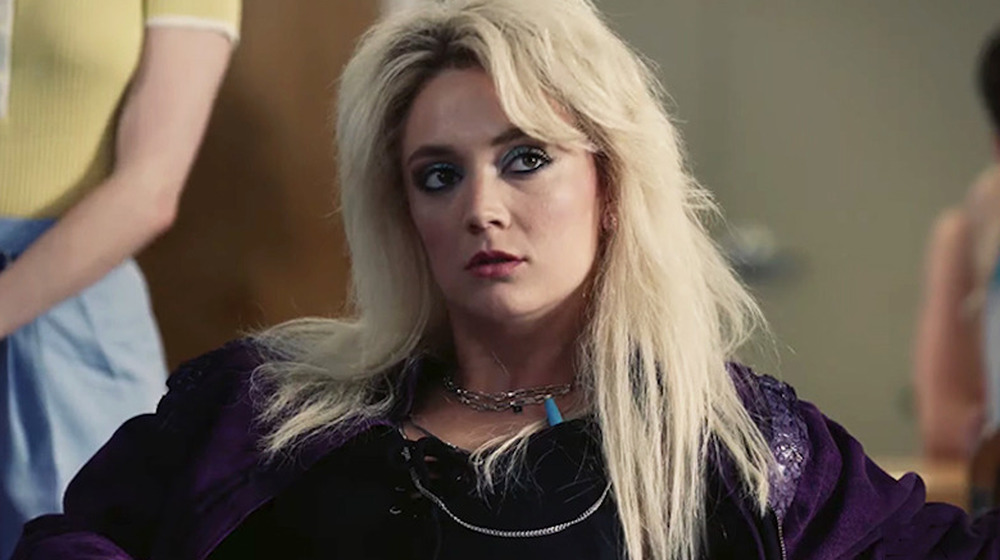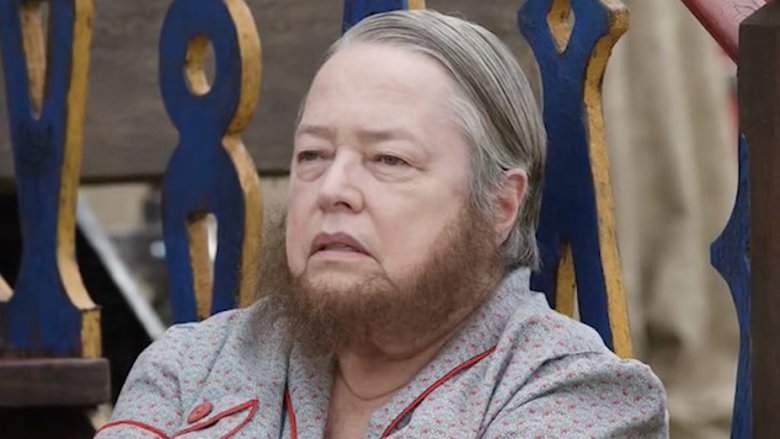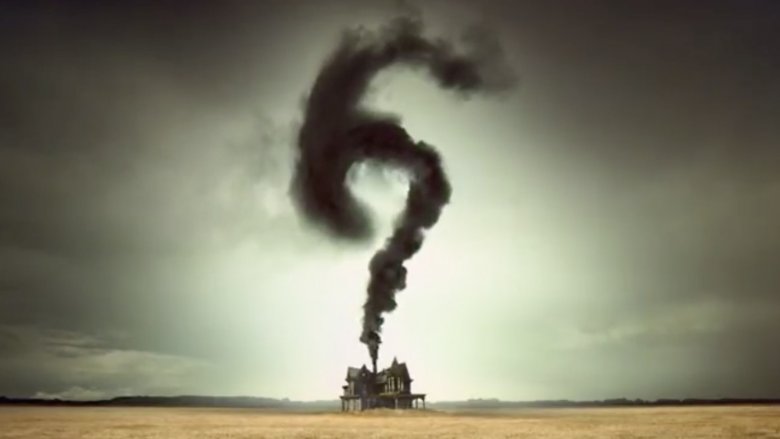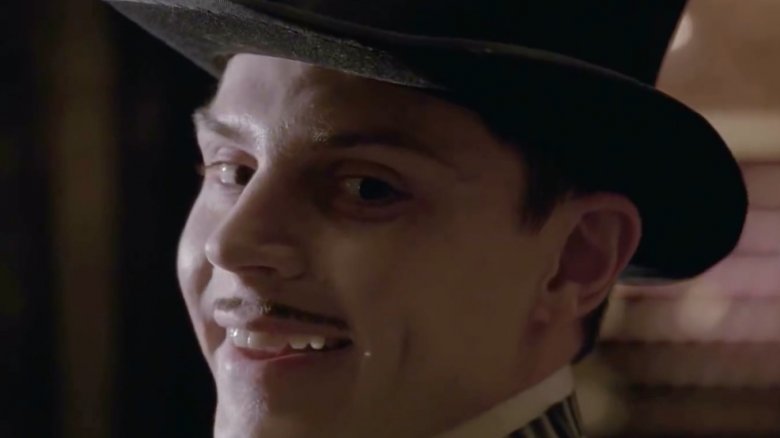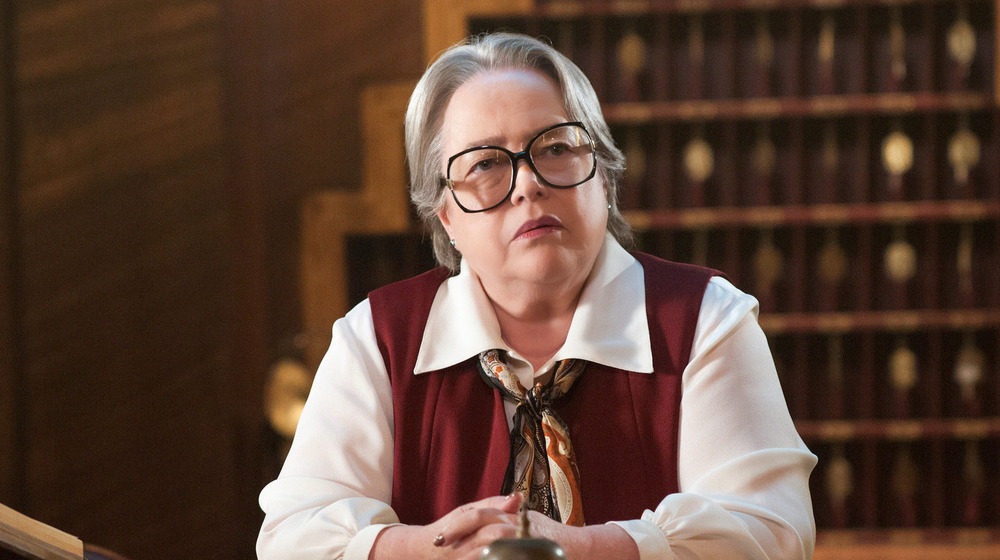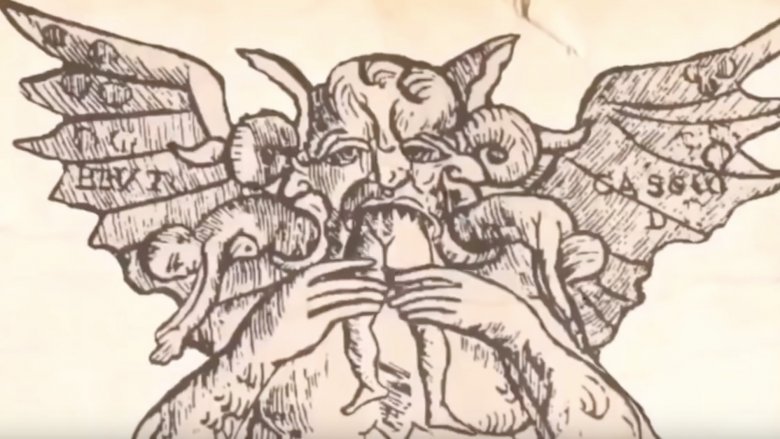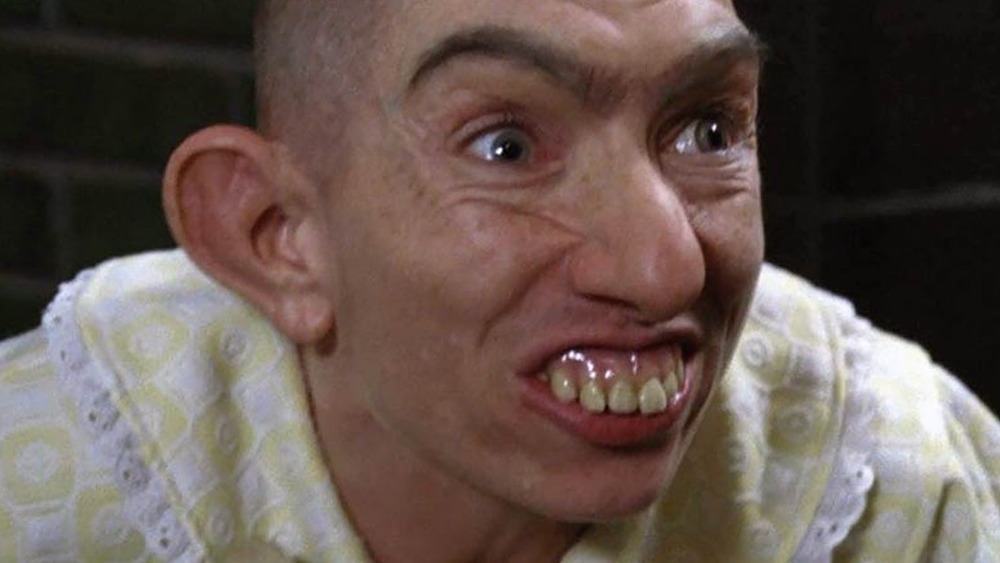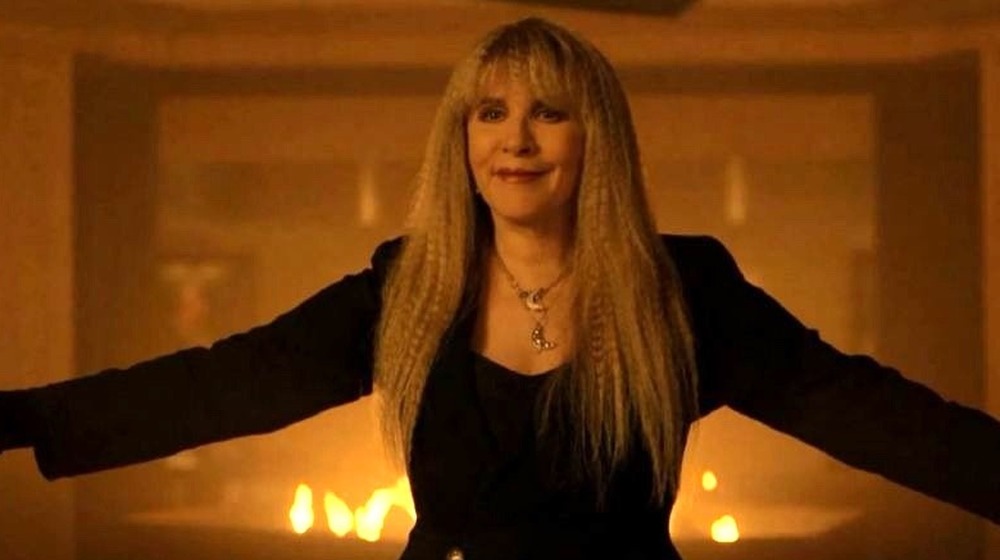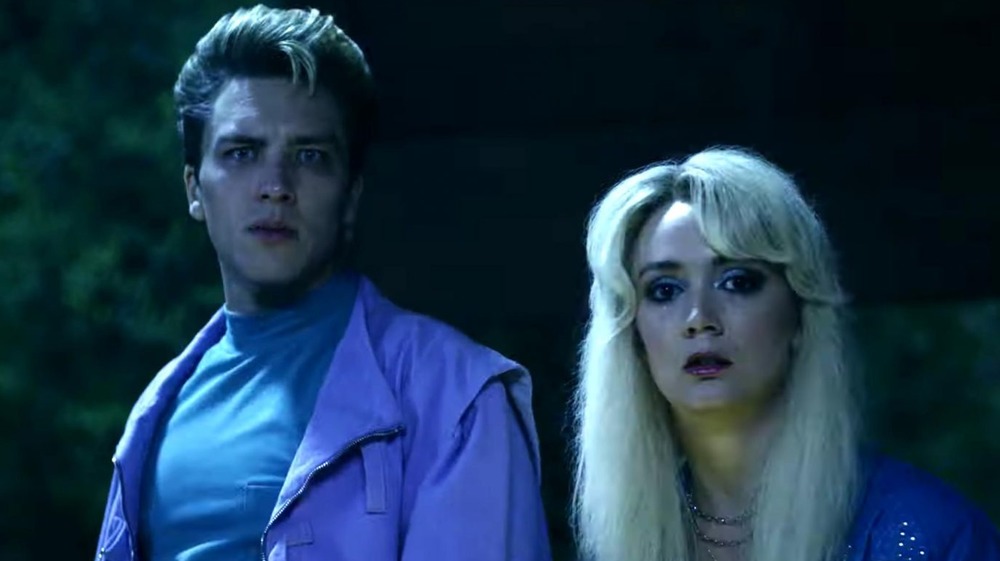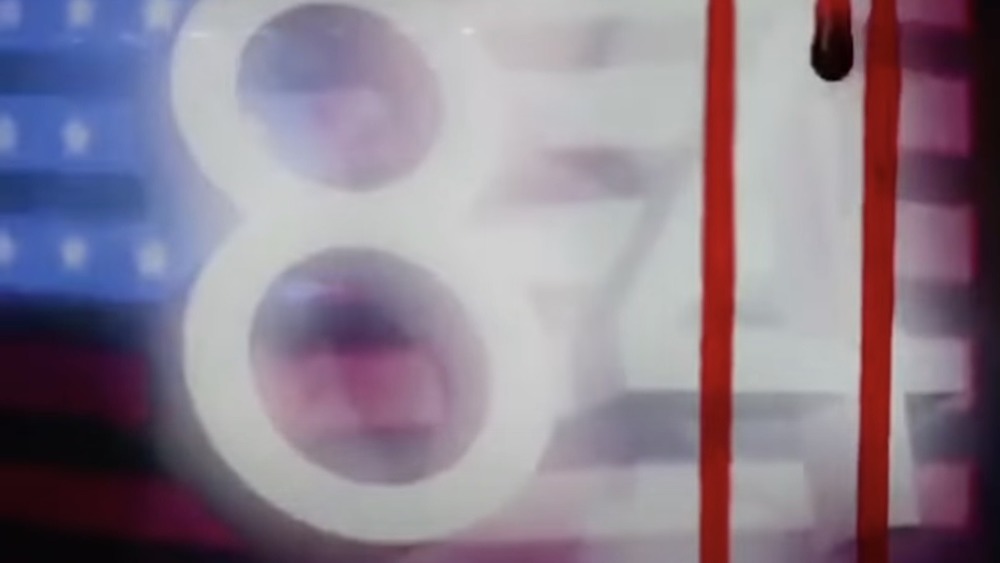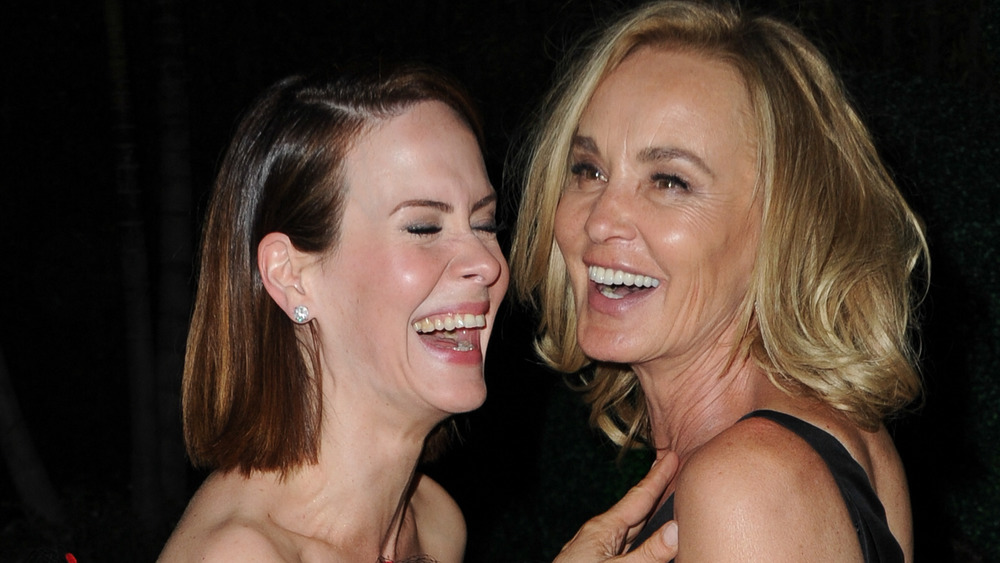The Untold Truth Of American Horror Story
A common format in the early days of television with classic shows like The Twilight Zone, Ryan Murphy and Brad Falchuk's American Horror Story is the first major anthology series in decades, with each season telling a complete, standalone story. Things are not always as they seem, however, as the show's eighth installment, Apocalypse, shook up that notion by linking almost every previous season together. Each of the stories — including Murder House, Asylum, Coven, Hotel, and Cult — is absolutely terrifying and deeply unsettling. At the same time, the show remains stylish, thoughtful, provocative, sensual, and hilarious.
Mainstream awards often overlook even the finest of horror television, but American Horror Story is so well made, and has such an impressive pedigree of talent, that Emmy voters bestow it with accolades year after year. Much of this success is certainly thanks to its cast, which includes such recurring repertory players as Jessica Lange, Sarah Paulson, Kathy Bates, Evan Peters, Angela Bassett, Emma Roberts, and Frances Conroy.
Here's a look behind the scenes into what it takes to bring a massive project like American Horror Story to the small screen.
A Glee-ful origin
Before American Horror Story debuted in 2011, co-creator Ryan Murphy was best known as one of the minds behind Glee, a show so happy and positive that it was literally about a bunch of high school kids gaining self esteem by singing and dancing to familiar pop songs. Murphy then went directly from his high school musical to a house full of murder, ghosts, suicide, and a Rubber Man. What happened to Murphy that he could make such a switch?
"I was like, 'I can't write any more nice speeches for these Glee kids about love and tolerance and togetherness,'" he later said in an interview with Elle. To that end, he wrote a show about sex, murder, and depravity instead.
As for a more direct trajectory of what inspired Ryan Murphy, best known for teen fare, to construct an interconnected universe of horrors both supernatural and psychological, he looked to two old favorites from the 1970s. "Like all my TV shows, it's rooted in a childhood obsession. Two actually: Dark Shadows and a movie called Don't Look Now," Murphy told Interview, referring to a gothic TV daytime serial about a vampire named Barnabas Collins and a Donald Sutherland movie about parents in the throes of grief after the death of a child. "What I really wanted to do was my version of Dark Shadows, where there are creatures and a soap opera and sex, because my grandmother used to make me watch Dark Shadows as punishment."
How Sarah Paulson entered a world of Horror
American Horror Story also allowed Ryan Murphy to right a Glee wrong. He'd wanted Sarah Paulson to play Emma Pillsbury, the OCD-stricken high school guidance counselor eventually portrayed by Jayma Mays, but Paulson was unable because she was starring in a Broadway play at the time. Murphy finally found a place for Paulson as medium Billie Dean Howard, the first of many memorable AHS roles she would step into.
A close creative ally to Murphy (she's starred in numerous other projects for him, including American Crime Story and Ratched), Paulson came into the writer-director's inner circle at the suggestion of American Horror Story mainstay Jessica Lange. Lange and Paulson had acted together in a 2005 Broadway revival of the Tennessee Williams classic The Glass Menagerie. In 2011, when development for the first season of American Horror Story was underway, and Jessica Lange had been cast in the lead role of Constance Langdon, she approached Murphy with the request to "find something for Paulson."
Oh, what a relief it is
While occasionally campy and darkly funny, most every season of American Horror Story gets pretty bleak. Playing murderers — and murder victims — can really get under the skin of the actors, so a few tried to lighten the mood and relieve the tension when necessary.
Zachary Quinto took on a major role in Asylum as Oliver Thredson. Another role he accepted: on-set music therapist. "I play my banjo on set a lot because it sort of livens up the mood," Quinto said. "And at first I was a little bit nervous about doing that and then people were like 'thank you for doing that, it makes it so much easier to work.'" Lily Rabe plays guitar in real life, and she'd play to provide "musical breaks" on tough days.
Jessica Lange, the grande dame of American Horror Story, convinced Ryan Murphy to put one of these melodic palette cleansers into the show itself. After a flashback revealed that her Asylum character had once been a singer in a band, Lange suggested a full-on fantasy musical sequence in the middle of a psychiatric institution — set to the classic '60s novelty song "The Name Game" — if only "because everything we do is so grim," as she told Vulture.
Some actors just weren't horror-able
In addition to legendary Oscar winners like Lange and Bates, American Horror Story has made stars out of up-and-comers like Emma Roberts and Evan Peters, and proved to the world long before A Star is Born that Lady Gaga could act. It's hard to believe that some performers couldn't or didn't want to be involved with the top-rated show. Chris Zylka (The Leftovers) booked a two-episode stint on Asylum as a deaf man, but a few months later, he exited because he didn't want to have to shave his head, a requirement of the role.
Ryan Murphy has also dutifully pursued a few dream cast members, albeit unsuccessfully. Among the targets he has revealed: Michelle Pfeiffer, Michael Chiklis, and Reese Witherspoon. "I wanted her to play something really twisted and f***ed up," Murphy said about Witherspoon to Entertainment Weekly. "But she's always booked."
Neil Patrick Harris and his husband, David Burtka, appeared in Freak Show, although Murphy earlier pursued the couple for Murder House — he wanted them to portray the bickering pair ultimately played by Zachary Quinto and Teddy Sears. "We had just played ourselves as a couple not getting along," Harris told Rolling Stone, referring to A Very Harold & Kumar 3D Christmas. "I thought, 'It just seems weird to do that twice, as individual actors to play a couple that hate each other twice. So I said 'no,' that we shouldn't do it."
Send in the clowns
Lots of people are afflicted with a fear of clowns, known as coulrophobia. It must be something about their frozen, exaggerated, and untrustworthy grins, or how their identity is concealed under white face paint. American Horror Story aptly exploited those fears in its Freak Show season, featuring John Carroll Lynch as the monstrous Twisty the Clown, who isn't so much a children's party entertainer as he is a guy who kills people with scissors and locks kids in an old school bus.
Perhaps unsurprisingly, this subplot upset some real-life clowns. "Hollywood makes money sensationalizing the norm," Clowns of America president Glenn Kohlberger (a.k.a. "Clyde D. Scope") said in response to Freak Show in 2014. "They can take any situation no matter how good or pure and turn it into a nightmare. We do not support in any way, shape, or form any medium that sensationalizes or adds to coulrophobia."
The protests flared up again in 2017, when American Horror Story: Cult once again featured evil clowns. "The role of a clown persona, regardless of their style of clowning, is meant to bring joy and laughter, to bring humor to a hurting world," World Clown Association president Pam Moody (a.k.a. "Sparky," the firefighting clown) told the Detroit Free Press.
American Horror Story offended the Church of Satan
The eighth season of American Horror Story, dubbed Apocalypse, tied together characters from multiple seasons in the ultimate crossover event to face the ultimate in evil: Michael Langdon (Cody Fern), offspring of Satan and therefore the antichrist. In the sixth episode of the story, "Return to Murder House," viewers learn that Michael realizes his evil abilities in full after a visit from Anton LaVey (Carlo Rota) and his top lieutenants, who ritually and brutally sacrifice a woman, remove her beating heart, and give it over to the young embodiment of true evil to feast upon.
It was a deeply upsetting scene for many viewers, but in a different way for the real-life Church of Satan. Anton LaVey was a real person (he died in 1997), who really did found the Church of Satan and wrote several books espousing the beliefs of the 10,000-strong organization. Present-day COS leaders objected to the portrayal of the church on American Horror Story. "Incredibly disappointing," the Church of Satan tweeted in October 2018 over "Return to Murder House." "Anton LaVey didn't believe in Christ or an Anti-Christ and sacrifice plays no role in Satanism. Lazy writers appropriated his name and image for their Devil worship drivel is unimpressive and boring," it continued.
Sarah Paulson put in twice the effort to play twins
"It's absolutely the most challenging thing I've ever seen any actor do ever," Ryan Murphy told The Hollywood Reporter, regarding Sarah Paulson's portrayal of Bette and Dot Tattler. The dual role found Paulson playing conjoined twins with two heads and one body, living among a traveling sideshow on American Horror Story: Freak Show. It was also one of the most challenging things the show's special effects artists ever had to attempt. It required a lot of old-fashioned trickery, labor, and digital manipulation for Paulson to convincingly play both characters.
First, the effects team took a mold of Paulson's own head and used it to build two sophisticated prosthetic heads: a Bette (to be used when Paulson portrayed Dot), and a Dot (for when Paulson acted as Bette). "So when Sarah is doing her coverage where she's Dot, she has on a fake head to her left, which is Bette, and it moves," Murphy said. "She literally has to do scenes with herself." Those scenes took as long as 15 hours to shoot (five times the Freak Show average), because everything with the Tattlers had to be filmed for close-up, in medium shots, for effects, and from various angles...twice.
A spinoff series? Nah, "Queen"
One of Ryan Murphy's other shows, Scream Queens, is the place where the horror and blood of his American Horror Story meets the comedy of Glee. The show's first season concerns an unknown killer in a latex suit, not unlike AHS: Murder House's Rubber Man. But reminiscent of Glee's school setting, the victims and others in their orbit are self-absorbed sorority girls and dumb frat guys on a college campus. It's also laced with references to classic slasher movies, such as the presence of Halloween's Jamie Lee Curtis in a major role.
Scream Queens nearly had a whole lot more in common with American Horror Story, having evolved out of an idea for a spinoff of Coven, the AHS season set at a school for young witches in New Orleans. Murphy changed his mind after a lunch with Fox executives. "We were talking about things that we loved that were not on the air, things that we loved growing up, movies that we loved watching," Murphy said. Once the subject of slasher movies came up, Scream Queens' own unique identity began to take shape.
An abandoned Scream Queens idea led to an American Horror Story season
While Scream Queens began life as an idea for a spinoff standalone season featuring characters from the Coven season of American Horror Story, the show with the same creator and many of the same cast members went the other way, and inspired a season of American Horror Story. Scream Queens, like American Horror Story, was an anthology, telling a different story each season, albeit featuring the same characters. In its first iteration in 2015, a killer ran wild on a college campus, and its second and final season in 2016 involved a murderer on a rampage in a hospital. While the first season of Scream Queens was running on Fox, co-star Oliver Hudson said on Bravo's Watch What Happens Live that creator Ryan Murphy had told him that the show, in the event that it was renewed for a second season, would shift its setting from a university to a "summer camp."
That, of course, didn't happen — Fox renewed Scream Queens, and the second season took place in a hospital. However, four years later, the eighth season of American Horror Story debuted on FX. A lengthy homage to 1980s slasher movies, the season subtitled 1984 took place primarily at Camp Redwood — a summer camp. It also starred Billie Lourd, a holdover from the Scream Queens cast.
Behind the "freaky" music
American Horror Story: Freak Show takes place in Florida among the denizens of one of few remaining "Cabinet of Curiosities" shows in 1952. A highlight of the season — albeit a jarring one — is the recurring motif of anachronistic music, meaning characters set in the show's world of the early '50s sing very famous songs recorded decades later. Evan Peters sings Kurt Cobain's Nirvana tune "Come As You Are," Jessica Lange takes a stab at both David Bowie's "Life on Mars?" and Lana Del Rey's "Gods and Monsters," Kathy Bates takes on Hole's "Doll Parts" (a la Courtney Love) and Sarah Paulson croons Fiona Apple's "Criminal."
Ryan Murphy explained that the songs were carefully selected for Freak Show, and for good reason. "We decided we only were going to highlight musical artists who at some point in their career had identified themselves as feeling like freaks or misfits or outcasts, which our people are going through," Murphy explained.
Trailer made for subterfuge
Extremely popular shows operate under tight on-set secrecy in the name of keeping plot details from leaking. In fact, it's not uncommon for show runners to film fake scenes to throw off any loose-lipped crew members, paparazzi, or spoiler-hunters. The sixth season of American Horror Story in 2016 marks one of the few times that a project was actually advertised with fake footage.
In the months before the show premiered, FX released more than 20 teasers for that iteration of American Horror Story. "One of them is accurate," FX CEO John Landgraf said at a Television Critics Association event. "The others are misdirects." All of them were creepy, weird, and a little unsettling, perhaps none more so than one of a nun using some hedge clippers on wind chimes made from human teeth. Turns out that was the real trailer, as that imagery figures into American Horror Story: Roanoke.
In a way, though, all of the fake trailers were "real." That season of the show explored the notions of "real" and "fake," as the plot centered on a couple who lived in a haunted house near the lost colony of Roanoke, and a TV show's re-creations of the events they endured.
The Hotel Cortez is not such a lovely place
In American Horror Story: Hotel, Evan Peters portrayed Mr. March, who turned out to be arguably the most purely evil character in the show's long list of purely evil characters, trapping, torturing, and murdering people in the Hotel Cortez. It's quite upsetting that, according to Ryan Murphy in Entertainment Weekly, Mr. March is based on a real person, "perhaps the worst human being to have ever lived."
That individual is H.H. Holmes, who, during the Chicago World's Fair in 1893, opened and utilized a "hotel of horrors." Visitors to the great exposition who tragically chose to board at Holmes' hotel would find their rooms soundproof and windowless, all the better for Holmes to murder them via gassing or other means. Secret passageways allowed him to remove bodies without detection to the basement, where he'd destroy the evidence in a furnace. He was caught in 1894, and executed two years later.
The Hotel from American Horror Story: Hotel has a real-life parallel
American Horror Story: Hotel took inspiration in part from the ghastly horrors committed by H.H. Holmes, and seemingly from something more modern and ambiguous as well. The Hotel Cortez is loosely based on the Cecil Hotel, a structure in the "skid row" area of downtown Los Angeles that's hosted countless tourists and transients as well as murderers and mysteries. Austrian serial killer Jack Unterweger resided at the hotel for a while, as did Richard Ramirez, the murderer known as the Night Stalker. He's even a character in American Horror Story: Hotel.
The one incident that really moved the needle for American Horror Story creator Ryan Murphy was the story of Elisa Lam. As explored in the 2021 Netflix documentary Crime Scene: The Vanishing at the Cecil Hotel, Canadian student Lam stayed at the Cecil during a trip to Los Angeles in 2013... and disappeared. An internet-powered manhunt ensued, especially after the release of a bizarre surveillance video of Lam acting erratically in a Cecil Hotel elevator. A few days later, Lam's body was discovered in a rooftop water tank. "A girl got in an elevator in a downtown hotel," Murphy said at a Television Critics Association event (via HuffPost) in August 2015. "She was never seen again."
Roll credits (the terrifying, clue-filled credits)
The sinister-sounding, postmodern opening sequence for American Horror Story seems tailor-made for the show, a combination of spooky, forbidding, and hypnotic musical themes punctuated by jarring jump-scare sounds. Surprisingly, the bulk of it comes from a 20-year-old class project. Back in 1998, César Dávila-Irizarry was a sophomore at the University of Puerto Rico. For a music history class, he created a primitive digital audio track, using Cool Edit 96 on his Windows 98 computer, stretching, mixing and combining various sounds with white noise. For example, the song's first dissonant moment comes from a clip of Dávila-Irizarry dropping wire hangers on a tile floor.
When he was done, Dávila-Irizarry gave it to his friend, Gabriel Diaz, who went on to work as a video editor on the first season of American Horror Story. He used Dávila-Irizarry's track as a placeholder, but producers liked it so much they decided to keep it. For technical and legal reasons, show composer Charlie Clouser of Nine Inch Nails recreated and spruced it up with Dávila-Irizarry's blessing.
How Pepper came to life
Apart from a couple of appearances as Church of Satan cardinal Samantha Crowe in the Apocalypse season, actor Naomi Grossman left her mark on the American Horror Story franchise in the second-season Asylum story. She portrayed Pepper, a woman who suffers from microcephaly (a smaller than normal head) and possesses many other notable physical traits, such as large ears, jutting teeth, a mostly shaved pate, and a top-knot. (Pepper also has carnival sideshow performance in her background, along with child murder.)
Grossman is almost unrecognizable as Pepper, and her physical transformation into the character for each episode of Asylum was a long and involved process. "The entire process takes about two and a half to three hours," Grossman told Entertainment Weekly, "and that's with two men working the entire time!" Freckles and veins were drawn on Grossman's skin, and then came extensive prosthetics, which included "a forehead complete with punched-in eyebrows, a nose, ears, and even a bumpy little spine-piece for my back." Grossman was also outfitted for a set of false teeth, which altered the shape of her mouth and face. Grossman additionally revealed that "there's even a wacky lens for one of my eyes" which made that eye unusable.
How Stevie Nicks joined American Horror Story
Songs recorded by Fleetwood Mac, as well as that band's Stevie Nicks, permeate the soundtracks of multiple American Horror Story seasons. That's logical, as Nicks has long been associated with witches, dark spirits, and other spooky stuff that's abundant in the Ryan Murphy horror anthology. (The Mac song "Rhiannon," for example, is about a witch from Welsh folklore.) Nicks' bewitching presence is felt most strongly in the third American Horror Story, subtitled Coven, where Lily Rabe plays a witch who deeply loves Nicks' music even before she finds out the singer is an actual, practicing witch, too. Nicks makes a cameo late in the season (in the episode "The Magical Delights of Stevie Nicks"), and it was tough for American Horror Story producers to make happen.
Nicks was friendly with AHS creators Ryan Murphy and Brad Falchuck, having lent a hand on a Fleetwood Mac tribute episode of their series Glee. "They asked me if they could use my music" on American Horror Story, Nicks told the Los Angeles Times. When they explained that her songs made her into a "friend," "mom," and "conscience" for the lonely Misty Day, Nicks acquiesced. When Murphy asked her to appear, she was terrified at first — she had a terrible time acting in a fourth grade play and "vowed to stay away" from acting forever.
The reason for the post-Apocalypse cast overhaul
Each year, the story, setting, and characters are different, but the actors remain the same. From the beginning of the American Horror Story anthology concept, creator Ryan Murphy has utilized a collective of performers, with many of them dutifully returning for each successive season. When it came time to shoot season nine, 1984, Murphy had to make do without the use of some of his most venerable actors. For example, Evan Peters starred in eight seasons, then left the show, citing burnout and an aversion to getting typecast in horror roles. Sarah Paulson also appeared in each of the first eight tales, and Jessica Lange bowed out after four seasons, then had a small, role-reprising cameo in the eighth season, which tied several different, disparate American Horror stories together. It also involved a large number of actors, which stretched FX's budget. "It was a monster in terms of the size of the cast, cost of that cast," FX CEO Jon Landgraf told TheWrap. Murphy had to, according to Landgraf, "clean the slate, start over." When American Horror Story: 1984 debuted, it boasted a cast comprised mostly of new and latter-day arrivals to the franchise, including Billie Lourd, Cody Fern, Leslie Grossman, and Matthew Morrison.
A fan designed the American Horror Story: 1984 credits
After the soft reboot of American Horror Story was announced, in the form of an '80s horror movie-influenced season called 1984, a series fan and video editor named Corey Vega made a preemptive cut of what he thought the upcoming episodes' opening credit sequence ought to look like. In short, Vega thought it should look extremely '80s. He put together a rapid-fire clip montage that included shots of aerobics instructors, neon-colored cars, moonwalking, and neon graphics. And because it's supposed to be an American Horror Story clip, lots of blood and gore permeated it all.
The video spread around the internet until it reached a very influential figure: American Horror Story co-creator and producer Ryan Murphy. "I liked it so much," Murphy wrote on Instagram, that he hired Vega to virtually and professional re-create his video with AHS titles designer Kyle Cooper to use on 1984.
Will American Horror Story's tenth season ever hit TV?
From 2011 to 2019, a new edition of American Horror Story aired every fall on FX. The network ordered a tenth season in the summer of 2018 — before season eight had aired and before nine had entered production. But then 2020 came and went without a new Horror, pushed back by FX due to coronavirus-shutdown-caused production delays. Creator Ryan Murphy already had a lot on his plate — FX also ordered a spinoff called American Horror Stories, in which each episode would tell a single story (as opposed to each season of the mother series) and in 2019, he signed a $300 million deal to move his productions to Netflix.
Filming being delayed by many months even threatened to change the nature of the series. "A lot of what I was going to shoot was dependent on a very specific moment, it was a weather-dependent show," Murphy told TheWrap. "I don't know what I'm gonna do next with that show. I don't know if I'll accelerate another season or wait till next year to shoot this one." While reports suggested filming would begin in December 2020, filming permits were filed for a February 2021 shoot in Provincetown, Massachusetts, under the name Pilgrim.
